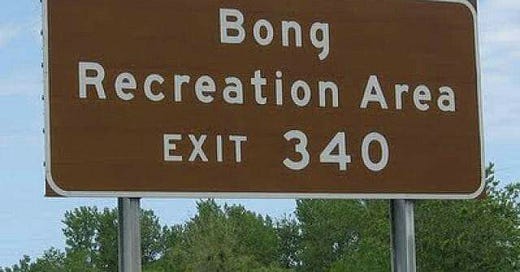If you’ve ever driven along I-94 through Kenosha County, near Wisconsin’s southern border, you’ve likely spotted the infamous brown freeway sign:
Bong Recreation Area – Exit 340
For years, this sign has been an unintentional source of amusement, especially in the early internet era, when it circulated as a kind of pre-meme. Road-tripping stoners who veer off at Exit 340, expecting a roadside head shop, are in for a surprise—Bong Recreation Area has nothing to do with cannabis. Instead, it’s named for Major Richard Ira Bong, one of America’s most celebrated World War II fighter pilots. But the park’s history goes deeper than just an iconic name; its origins tell a fascinating story about Cold War America, political debates, and an abandoned military project that reshaped the Wisconsin landscape.
From Farmland to Fighter Jets
The 1950s were an era of high Cold War anxiety. Wisconsin’s most infamous senator, Joseph McCarthy, was fueling the Red Scare, and fears of Soviet bombers loomed large. The U.S. Air Force, seeking to protect major cities, scouted locations for a new defensive air base. The quiet, unincorporated farming community of Kansasville, Wisconsin—situated between Milwaukee and Chicago—was chosen as an ideal site.
This was no small project. The planned base would house eight heavy bombers, 45 medium bombers, 25 fighter-interceptors, and 20 flying tanker escorts. In 1956, Congress approved the acquisition of over 5,000 acres of farmland, displacing more than 70 families. The reaction was mixed—some saw economic opportunity in the arrival of thousands of airmen, while others mourned the loss of their generational farms or worried about deafening jet noise.
It was during this time that officials decided to name the base after Major Richard Ira Bong.
The Hero Behind the Name
Richard Ira Bong was born in 1920 in Superior, Wisconsin, and grew up on a farm in nearby Poplar. His love of flying took hold in college, and in 1941, he enlisted in the Army Air Corps. Early on, his talent in the cockpit was undeniable—though he got into trouble for performing daring low-altitude flybys over his buddy’s house after a wedding. The military largely overlooked his aerial antics, and for good reason: Bong became the top American flying ace of World War II, credited with downing 40 Japanese aircraft.
Returning home in 1945 as a national hero, Bong married his sweetheart and took a test pilot job in California. Tragically, his career was cut short just months later when his plane malfunctioned during a test flight. He ejected, but at too low an altitude for his parachute to deploy. Bong’s death at age 24 made national headlines—second only to the bombing of Hiroshima, which occurred the same day.
Naming the new Wisconsin air base after the young war hero seemed like a fitting tribute. But as construction finally began in 1958, doubts about the project’s viability were growing.
A Base That Never Was
By the late 1950s, Cold War hysteria was fading, and so was the free flow of government funding. Opposition to the Bong Air Base grew, with critics calling it an unnecessary expense. Concerns also arose about its proximity to Milwaukee’s Mitchell Field and Chicago’s O’Hare, where military jets would share airspace with commercial planes.
Wisconsin lawmakers found themselves on both sides of the debate. Some saw the base as an economic boon, while others warned it would become a costly “white elephant.” Despite these concerns, construction inched forward. Millions were spent on infrastructure, including wells and sewer systems. Yet, as delays mounted and costs skyrocketed, support for the base crumbled. In 1959, after an investment of $29 million (over $300 million in today’s dollars), the project was canceled outright.
The land, however, was forever changed. Over 2,000 acres had been stripped of topsoil, 400 acres were covered in soil dumps, and 1,600 acres were flattened for airstrips that would never see a single takeoff. The once-fertile farmland was now a scarred, abandoned landscape.
From Cold War Casualty to Outdoor Haven
For years, the site sat unused as state and federal officials debated what to do with it. Finally, in 1974, the Wisconsin Assembly passed a bill designating the land as a recreation area—one that would retain the name of Wisconsin’s famous flying ace.
Today, the Bong Recreation Area is one of the state’s most versatile outdoor destinations, offering camping, hiking, fishing, hunting, ATV trails, and even a designated model rocketry area. It features accessible trails, campsites, picnic shelters, and a fishing pier, making it a welcoming spot for all visitors.
And that infamous freeway sign? It remains one of the most stolen in the country, ensuring that the legend of Bong Recreation Area endures—one way or another.





Great history Jenn. I mean really..... Bong Recreation Area?!? Of course its getting stolen. Do you remember a tiny little road, just a spur, with no one living on it, that was a trailhead on the Ice trail? Funk Rd. The sign got stolen so often they changed the name of the road.. It was somewhere north of Lapham if I remember correctly, near holyhill and Loew Lake.
"Oh, duuuude, let's smoke a bowl there..."
"Nah, man, the place is full of cops. It's a trap!"
Oh, far out, man."